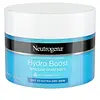Neutrogena Hydro Boost Whipped Body Balm Versus Vaseline Clinical Care Rough Hands Rescue Hand Cream
What's inside
What's inside
 Key Ingredients
Key Ingredients

 Benefits
Benefits

 Concerns
Concerns

 Ingredients Side-by-side
Ingredients Side-by-side

Water
Skin ConditioningGlycerin
HumectantIsopropyl Palmitate
EmollientPetrolatum
EmollientDimethicone
EmollientCetyl Alcohol
EmollientSodium Acrylates Crosspolymer-2
AbsorbentPhenoxyethanol
PreservativeCetearyl Olivate
Ethylhexylglycerin
Skin ConditioningSorbitan Olivate
EmulsifyingCarbomer
Emulsion StabilisingParfum
MaskingXanthan Gum
EmulsifyingSodium Hydroxide
BufferingSodium Hyaluronate
HumectantBlue 1 Lake
Cosmetic ColorantWater
Skin ConditioningGlycerin
HumectantDimethicone
EmollientHydroxystearic Acid
CleansingSodium Hydroxypropyl Starch Phosphate
AbrasiveIsopropyl Myristate
EmollientPetrolatum
EmollientCetearyl Alcohol
EmollientGlyceryl Hydroxystearate
EmollientCaprylyl Glycol
EmollientPhenoxyethanol
PreservativeStearic Acid
CleansingCetearyl Glucoside
EmulsifyingCitrus Limon Peel Powder
AbsorbentCitrus Aurantifolia Peel Powder
Skin ConditioningDisodium EDTA
CI 77891
Cosmetic ColorantWater, Glycerin, Dimethicone, Hydroxystearic Acid, Sodium Hydroxypropyl Starch Phosphate, Isopropyl Myristate, Petrolatum, Cetearyl Alcohol, Glyceryl Hydroxystearate, Caprylyl Glycol, Phenoxyethanol, Stearic Acid, Cetearyl Glucoside, Citrus Limon Peel Powder, Citrus Aurantifolia Peel Powder, Disodium EDTA, CI 77891
Ingredients Explained
These ingredients are found in both products.
Ingredients higher up in an ingredient list are typically present in a larger amount.
Dimethicone is a type of synthetic silicone created from natural materials such as quartz.
What it does:
Dimethicone comes in different viscosities:
Depending on the viscosity, dimethicone has different properties.
Ingredients lists don't always show which type is used, so we recommend reaching out to the brand if you have questions about the viscosity.
This ingredient is unlikely to cause irritation because it does not get absorbed into skin. However, people with silicone allergies should be careful about using this ingredient.
Note: Dimethicone may contribute to pilling. This is because it is not oil or water soluble, so pilling may occur when layered with products. When mixed with heavy oils in a formula, the outcome is also quite greasy.
Learn more about DimethiconeGlycerin is already naturally found in your skin. It helps moisturize and protect your skin.
A study from 2016 found glycerin to be more effective as a humectant than AHAs and hyaluronic acid.
As a humectant, it helps the skin stay hydrated by pulling moisture to your skin. The low molecular weight of glycerin allows it to pull moisture into the deeper layers of your skin.
Hydrated skin improves your skin barrier; Your skin barrier helps protect against irritants and bacteria.
Glycerin has also been found to have antimicrobial and antiviral properties. Due to these properties, glycerin is often used in wound and burn treatments.
In cosmetics, glycerin is usually derived from plants such as soybean or palm. However, it can also be sourced from animals, such as tallow or animal fat.
This ingredient is organic, colorless, odorless, and non-toxic.
Glycerin is the name for this ingredient in American English. British English uses Glycerol/Glycerine.
Learn more about GlycerinPetrolatum is more commonly known as petroleum jelly. It is created by mixing waxes and mineral oils.
This ingredient is effective at reducing water loss by 99%. This is because it is an occlusive. Occlusives create a hydrophobic barrier on the skin to prevent evaporation. This property makes it great for hydrating dry skin.
Pro tip: Use occlusives, such as this ingredient, on damp skin for the best results.
The quality or origin of petrolatum is only known when disclosed by the brand. Most cosmetic petrolatum has gone through several purification stages.
Another benefit of occlusives is it protects your skin against infection or allergies.
Petrolatum may not be safe for fungal-acne. Studies show mineral oil / petroleum leads to the growth of M. Furfur, a type of yeast.
Learn more about PetrolatumPhenoxyethanol is a preservative that has germicide, antimicrobial, and aromatic properties. Studies show that phenoxyethanol can prevent microbial growth. By itself, it has a scent that is similar to that of a rose.
It's often used in formulations along with Caprylyl Glycol to preserve the shelf life of products.
Water. It's the most common cosmetic ingredient of all. You'll usually see it at the top of ingredient lists, meaning that it makes up the largest part of the product.
So why is it so popular? Water most often acts as a solvent - this means that it helps dissolve other ingredients into the formulation.
You'll also recognize water as that liquid we all need to stay alive. If you see this, drink a glass of water. Stay hydrated!
Learn more about Water